EBOOK
The Ultimate Guide to Customer Journey Optimization
Published: Jul 13, 2017

Customer Journey Optimization (CJO) is the new conversion rate optimization (CRO). As an eCommerce company, in order to keep competing and keep converting in an increasingly competitive market, you need to create a data-backed customer journey map – and be an expert at making it relevant and seamless. Because if you don’t, your competitors will.
In this guide, you’ll get step-by-step pointers on how to map out your customer journey and then optimize it, along with examples of brands who are excelling at this. By the end, you’ll see your brand – and hopefully your customer – in a whole new light.
Why care about CJO?
In digital marketing, there are a lot of three-letter acronyms. SEO. CRO. CMS. ROI.
Today we’re here to talk about another one: CJO. Expanded, that’s customer journey optimization. But before you discard it as just another three letters, you should know why this one is so important.
72% of businesses say that improving customer experience is their top priority.
Forrester
Making your customer experience personal, seamless, and relevant is the new battleground. New research shows that for the majority of your customers, this is now a table-stakes expectation and over 50% of them will happily walk away to another brand if you fail to tailor their experience.
Any brand whose customers experience difficulty, confusion or frustration risks losing them to other, slicker operations. That’s across the entire customer journey – from awareness to purchase to advocacy.
In pre-digital days, a customer journey might start with a television or print ad, continue with a phone call or a visit to the store, and end with a purchase.
Today, the proliferation of media channels, the ease of comparison, and the immediacy of digital research and online buying means that customer journeys have become more complex and less linear.
That’s why smart brands operating across multiple channels are turning to customer journey mapping and optimization. At its simplest, this means seeing the brand-customer relationship from the customer’s perspective, not the marketer’s.
Right now, experience is the biggest challenge facing digital marketers, with 30% citing UX and CX as their main pain point.
Flipping your funnel preconceptions on their head is fundamental to eCommerce success – in order to successfully turn browsers into buyers, you need to start by understanding your customer’s journey.
Getting to grips with the real story of how a customer interacts with your brand is going to mean:
- Breaking the silos that divide marketing and customer service channels.
- Learning to re-evaluate how you measure your success.
- Successfully creating customer journeys that convert – time and time again.
What is Customer Journey Optimization?
Customer Journey Optimization, CJO, is sometimes called the new conversion rate optimization – but it’s so much more than that.
Where conversion rate optimization views the buying process as relatively linear in order to nudge visitors towards a conversion goal, CJO accounts for all customer touchpoints and works to optimize them across the entire lifecycle.
Let’s break that down.
We’re all familiar with the usual customer interactions: the ‘chat with us’ window, the checkout experience, your email marketing, and social media output, your search function, television advertisements, blog posts, and customer service call centers. They’re part of the brand experience – but what good are they in isolation?
What actually counts for the consumer is the cumulative effect of the end-to-end experience of dealing with the brand. There’s no point in having a great checkout experience if the rest of the website is frustrating and obscurely laid out; great content can’t tell your brand story if it’s not delivered in a way that makes sense for the consumer.
Your customers don’t see your individual touchpoints in isolation. They see the total experience you give them as a whole, which is an aggregation of multiple interactions across multiple channels (and usually, multiple departments and P&Ls). That’s why CJO is so important.
The numbers speak for themselves – companies with strong omnichannel strategies retain an average of 89% of their customers. The ones with weak omnichannel strategies retain only 33%.
Customer journey optimization is the science of making every engagement with your customer – from awareness to loyalty – relevant, seamless and the best it can possibly be.
What impact does Customer Journey Optimization have on your business?
A study by McKinsey & Co. perfectly illustrates the importance of optimizing and measuring the customer journey as a whole, rather than individual touchpoints.
A media company was losing customers at an alarming rate – but its customer satisfaction rates at touchpoints like call centres, website services and field services rated consistently at 90%. Yet when the team dug deeper, they found that customers were leaving because of poor customer service.
The issue, they discovered, was that although each time a customer connected with a touchpoint they came away with their issue resolved, the underlying problems creating the issues were left unaddressed. For example, while one phonecall had a 90% chance of going well, it might have taken three phone calls to get the issue resolved.
The company’s processes were broken, and the cumulative experience of this customer journey – rather than the individual touchpoint events – was what was driving customers away.
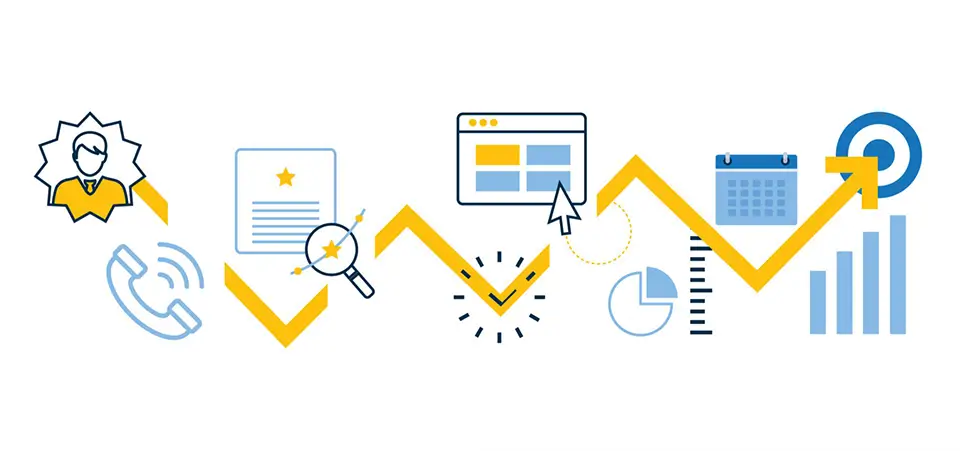
The lesson here is that failing to see your touchpoints as a journey – as your customers do – has a real impact on the bottom line.
By providing a seamless and relevant customer journey, you’ll significantly increase your chances of selling to a new customer (78% of customers in the US report having abandoned a transaction due to a poor customer experience) – and also be more likely to sell again to an existing customer (the probability of selling to an existing customer is 60-70%, compared with 5-20% for a new customer).
How to start with Customer Journey Optimization
1. Create a customer journey map in 10 simple steps
If you’re ready to tackle CJO, first you’ll want to create a customer journey map. Your map will take in all your touchpoints, channels and personas. It’s a visualization of an individual’s journey to purchase and beyond.
It’s important at this stage to not be intimidated by the task at hand. While some large organizations’ maps are extremely complicated, yours may well be simple. There are two key things to remember as you map your customer journey:
- Think of it from the point of view of the customer, not the business.
- Don’t assume that a customer journey will be linear and predictable.
Get into the mindset of a consumer and consider all the possible ways they might interact with your brand, and you how you might be able to make those interactions and everything in between a pleasurable experience.
Here are 10 simple steps you must take in order to create a comprehensive customer journey map:
1. Define your objectives. Know what you want out of this exercise before you start, because it’s going to take a fair bit of work to scope. Do you want to build your customer journey from the ground up or are you looking to optimize your existing pathways?
2. Get all the right teams involved. Your customer doesn’t know or care that one person in your business handles social media while another team looks after post-purchase fulfilment – to them, you’re one brand and one experience. You need every type of interaction represented on your map, so make sure that the people responsible for them are all in the room. Overcoming the problems of internal silo is one of the key issues at stake here, so it has to be on the agenda from the outset.
3. Don’t worry about the templates. There are many different ways to present a customer journey, so don’t spend time worrying about which one to choose. Start with a simple flowchart – it may evolve as you start to see the picture develop, but it will give you a grounding.
4. Start with your customer personas. Different personas may have different journeys which reflect their varying needs, values, expectations and pain points. How would a 50-year-old Christmas panic-buyer experience your store differently to one of your loyal customers? You may need multiple journey maps, but as long as you’re looking at this from your customer’s perspective, you’re doing the right thing.
5. Gather your datasets. We live in a data-rich world, so now’s the time to pull all your user data together. That’s web and social analytics, demographic information, customer feedback and anything else you have that provides intelligence on customer behavior. Of course, there’s often more to the story than what can be seen in an analytics dashboard. Interview customer-facing staff, explore your bricks-and-mortar environments (if you have them) and talk to any partners that might be sending customers your way.
6. Start mapping your customer touchpoints. Start plotting out your customer interactions as a simple flowchart; you’ll see points of divergence and convergence, multiple potential pathways and lots of crossovers. The important thing is to start getting it all down on paper.
7. Add the internal actions. Part of what you’re doing here is overcoming internal silos between teams and channels, so you’ll want to make it clear where potential breakdowns are taking place on your map by noting the internal actions that take place following a customer interaction. For example, if a customer raises a complaint via social media how is that then passed to the right team for it to be handled?
8. Track timeframes. As your customer progresses, note how long it often takes between one touchpoint and the next. This, along with your view of ‘what happens next’ internally, will help you start to identify where things can be improved.
9. Note customer emotions. Consider the thoughts and emotions that your customer might be experiencing at any point where they might be in contact with your brand. Curiosity, desire, frustration, having to satisfy a physical need, surprise, uncertainty – understanding what they feel and when adds depth to the customer journey map.
10. Note your evaluation criteria and metrics. You likely have a wealth of metrics, goals and benchmarks that your teams use to evaluate their success in engaging with customers – survey scores, open rates, abandonment rates (the list goes on). Note them down next to each of your touchpoints.
We’ve seen in the earlier case study that your individual touchpoint metrics don’t necessarily represent the full picture; nonetheless, including your success metrics here will at least give you an indication of where some potential problem areas are.
2. Score it!
Just like we saw in the earlier case study where individual touchpoints scored highly only for the overall customer journey to perform poorly, this is the real acid test. By now, you’ll be able to see where long lag times might be in getting issues resolved, where internal communications aren’t seamless or where certain channels perform poorly.
From where your customers start to how they get to their goal, grade how well that journey performs. In an ideal world, you’ll be able to validate this against customer surveys or your overall success with that customer persona. Contrasting the performance of your multiple customer journeys will start to help you identify the places where you need to optimize, which leads you smoothly onto…
3. Find your ‘moments of truth’
Now that you have a clear view of your existing customer journey and how well it’s working, you’ll now start taking steps into optimizing.
The key here is focus. In order to optimize effectively, you’ll start by identifying those touchpoints you can change that are going to make the biggest impact. These are also known as your ‘moments of truth’ – the touchpoints that are make-or-break to your customer journey:
- The elements that are essential and can turn the whole experience sour if they underperform – for example, failing to respond to a customer query promptly.
- The elements that can take your customer journey to the next level – for example, personalized incentives based on a customer’s product interest.
This is what you’ll focus on changing first.
4. Re-shape your customer journeys
Now that you know what your moments of truth are, you can decide based on your research how you’ll change them. To gauge whether you’re making the right choice, take your existing customer journey map and draw up the changes to your moments of truth with the expected consequences of doing so.
This is important for two reasons – it’ll help you in getting buy-in when it comes to execution (see next step) and will also give you a measurement benchmark when it comes to evaluating the success of your intervention.
5. Get the business on board
You’ll hopefully have involved stakeholders from across the business in your customer journey mapping exercise, so getting buy-in for your optimization plans should hopefully be easier.
Remember, a key part of this exercise is overcoming issues with internal silos and process to make your organization operate efficiently around the customer – this step is essential to achieving a better customer journey. Don’t worry if it’s tough – 41% of marketers have exactly the same problem, citing organizational alignment as the biggest hurdle standing between them and their goals.
6. Implement
Time to execute.
7. Measure and iterate
So you’ve implemented your ‘moment of truth’ optimizations, knowing what your objective is; now it’s time to evaluate whether or not you’ve been successful.
Remember that CJO – like CRO – is a marathon, not a sprint and the goal is as much about finding out what doesn’t work as much as what does. Be patient and be persistent.
If you don’t get the result that you hoped for, analyse what did happen in an attempt to find out why that was the case -–that will help you decide what to try instead.
Focus area: Your website visitor journey
Probably the most interesting – and most important – part of the eCommerce customer journey is on your website. It’s here that you either make the sale – or don’t. This is where the rest of the work that you put into your customer journey succeeds or fails.
Crucially, it’s also where the most valuable data can be found. It’s here that you see everything about your customer – from their product interest (or lack thereof) to their regularity of engagement, the devices that they use to do so and what channels they arrive through.
The combination of a data goldmine and a wealth of ‘moments of truth’ means that the onsite experience is the key part of your customer journey.
So how do you ensure that your journey is going to work?
1. Track progression through your sales funnel
You know where your traffic has come from – whether it’s search, social, display or email – so your first task is to map out where it might go next.
Mapping out your website into different phases – from search, to category, to product, to checkout – and then tracking your traffic across them will show where you’re facing cart abandonment.
This is your first indicator as to what points of your visitor journey need optimization and investment – your ‘moments of truth’ for your visitor journey.
2. Get context
The challenge when you’ve mapped your funnel is knowing what ‘good’ looks like – for your category, what should a ‘normal’ bounce rate look like? This is where it’s invaluable to benchmark your customer journey against other comparable ones in your category – the data can be hard to come by, so this is where you may want to enlist some extra help.
3. Revive your key selling points
Now you know the points of your visitor journey at which you need to make interventions, it’s time to consider what they should be – and for whom.
For example, you might have free delivery as standard above a certain spend threshold, but you might also offer a 10% discount to first-time customers. Think about who you want to target at that point in your journey to understand what kind of message will make the difference at your ‘moment of truth’.
For example, Virgin Trains used three key messages to revive the interest of disengaged visitors on its booking pages, emphasizing the speed of checkout, no booking fees and no credit card charges. This led to a conversion rate increase of over 7% on this journey.
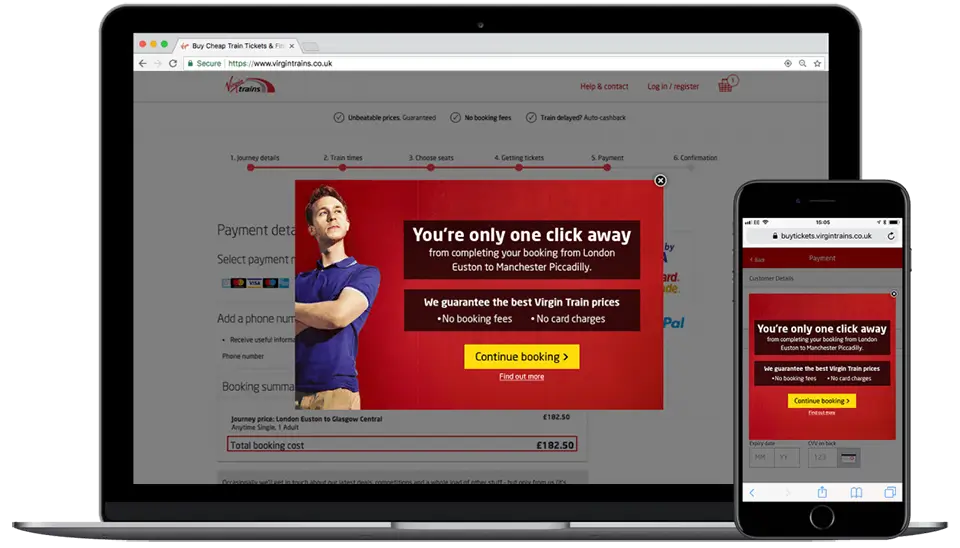
Which brands create successful customer journeys?
There are countless features of the customer journey, but you can break them down into five broad categories:
- Awareness
- Discovery
- Purchase
- Use of the product or service
- Bonding with the product
While this is just one way of defining the different phases, in a well-thought out customer journey, each of these aspects will be seamlessly interconnected and made relevant to the individual customer.
Here are some examples where brands have put resources into understanding their customers and creating an experience to suit them:
Awareness
Smashbox is a cosmetics brand that has brick-and-mortar stores and concessions – but a clever piece of digital activity allows customers to interact with the brand’s products by uploading their own selfies and experimenting with colour and style in a virtual try-on studio.
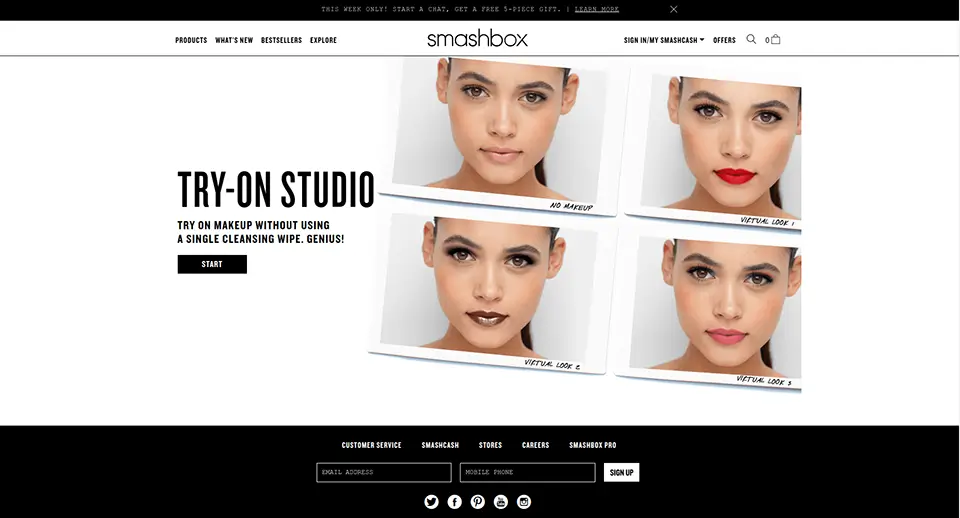
The benefit of this for Smashbox is twofold: firstly, this useful, personalized and innovative experience helps draw visitors in at the awareness phase of the customer journey.
Secondly, it delivers a relevant and interactive experience for eCommerce customers at the consideration stage of the process – a difficult challenge to overcome for a beauty brand where purchase consideration usually has to involve getting hands-on with a product.
Importantly, the studio works seamlessly on mobile devices as well, and Smashbox’s Chat with an Artist function delivers a specialist experience that creates a strong overall customer journey.
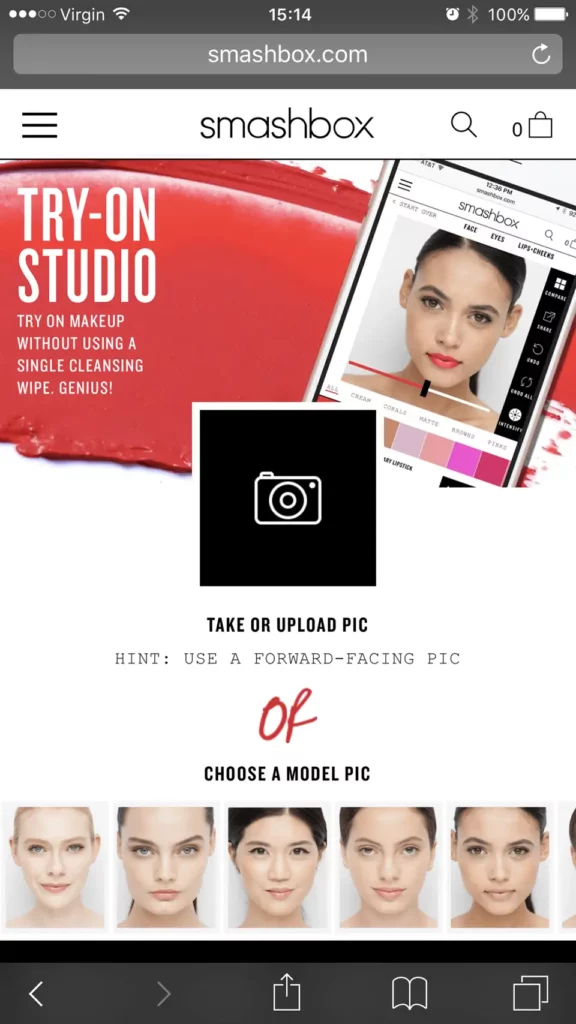
Discovery
John Greed Jewellery has considered its product from the customer point of view; realizing that jewellery is frequently given as a gift, its online store is arranged to easily guide the customer to the kind of gift they might want to buy, doing the job of a sales assistant in a physical store:

Purchase
As an insurer that specializes in coverage for the over-50s, Staysure provides a one-stop-shop for consumers to explore holiday ideas, book holidays, and arrange insurance. When you click on ‘holidays’, it leads you to the Staysure Travel site, an extension of the Staysure brand.
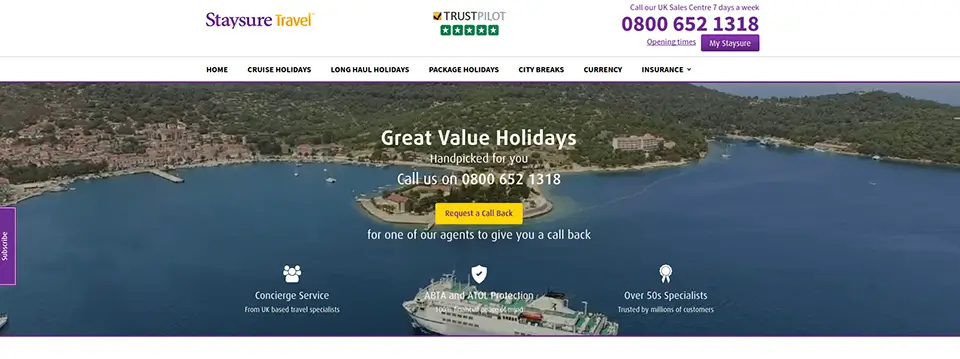
Whereas a typical insurance site may offer levels of cover and pricing (once your holiday is already arranged), Staysure has identified the appeal of an all-in-one experience for their target audience, who might otherwise find the online booking process daunting or overwhelming.
Importantly, the website places a contact number prominently, again recognizing that older browsers may be more likely to prefer to speak to someone than using an online checkout. It’s a good example of looking beyond channels and internal silos to see the experience from the customer’s point of view.
Use of product or service
Petcircle.com.au optimizes the customer’s ease of using the product – pet food – by offering an option of a recurring delivery. This simple option makes it easy to continue using the product – which the customer would need to re-purchase regularly – saving time and effort for the online shopper.
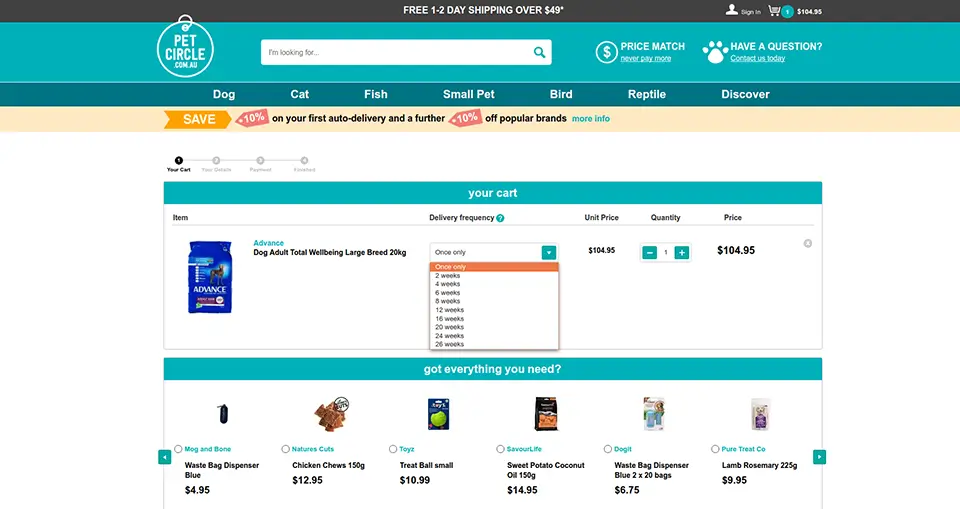
It also shows that the customer doesn’t have to be continually re-visiting a website, for example, in order to continue to interact with a brand. For a brand such as Pet Circle, the execution of those repeat re-orders, from email reminders to prompt delivery and easy cancellation, are just crucial to ensure the continuity of the experience.
Bonding with the product
Creating positive associations with the product after it’s been bought is an important first step to turning conversion into loyalty. After all, the customer journey is really only just beginning at this point.
Many brands use the ‘surprise and delight’ tactic – executed at the right ‘moment of truth’ – of putting in just that little bit extra in terms of thought and care. A pair of socks like in this Laura Ashley example doesn’t cost much to produce and send, but its value is potentially immeasurable – it turns customers into advocates.

Tip: A great customer journey isn’t just for those who purchase. LinkedIn blogger Scott Barbour recounts several interesting examples of great customer journeys (and one terrible one) that includes an experience where he decided to return the product – but where the customer services representative offered free shipping on a heavy item.
Conclusions
To keep acquiring and retaining customers, eCommerce businesses need to put customer journey optimization front and center. After all, over half of customers are willing to pay more for a good experience.
If you want to keep up, you’ll need to get started fast – this is a marathon, not a sprint – and keep in mind the following learnings from this book:
- Most of the CJO work is in the exercise of mapping the journey – this is the opportunity for your business to put aside how you view yourselves and really come to understand how your customers view you.
- Collaboration is crucial – make sure that all of your internal stakeholders are on board; this is important not just to ensure that your mapping exercise is complete, but that you’ll be ready to execute seamlessly on your optimization strategy across all your channels and touchpoints.
- Work from as much data as you can. Including data that’s not your own – being able to benchmark your activity against comparable businesses will help you understand where to focus your efforts for maximum return.
- Be ready to be surprised. What you’ll learn in the process of mapping and optimizing your customer journey will show the variety of experiences your different customers can have. Be prepared to re-think your personas and even your positioning if your data points in that direction.